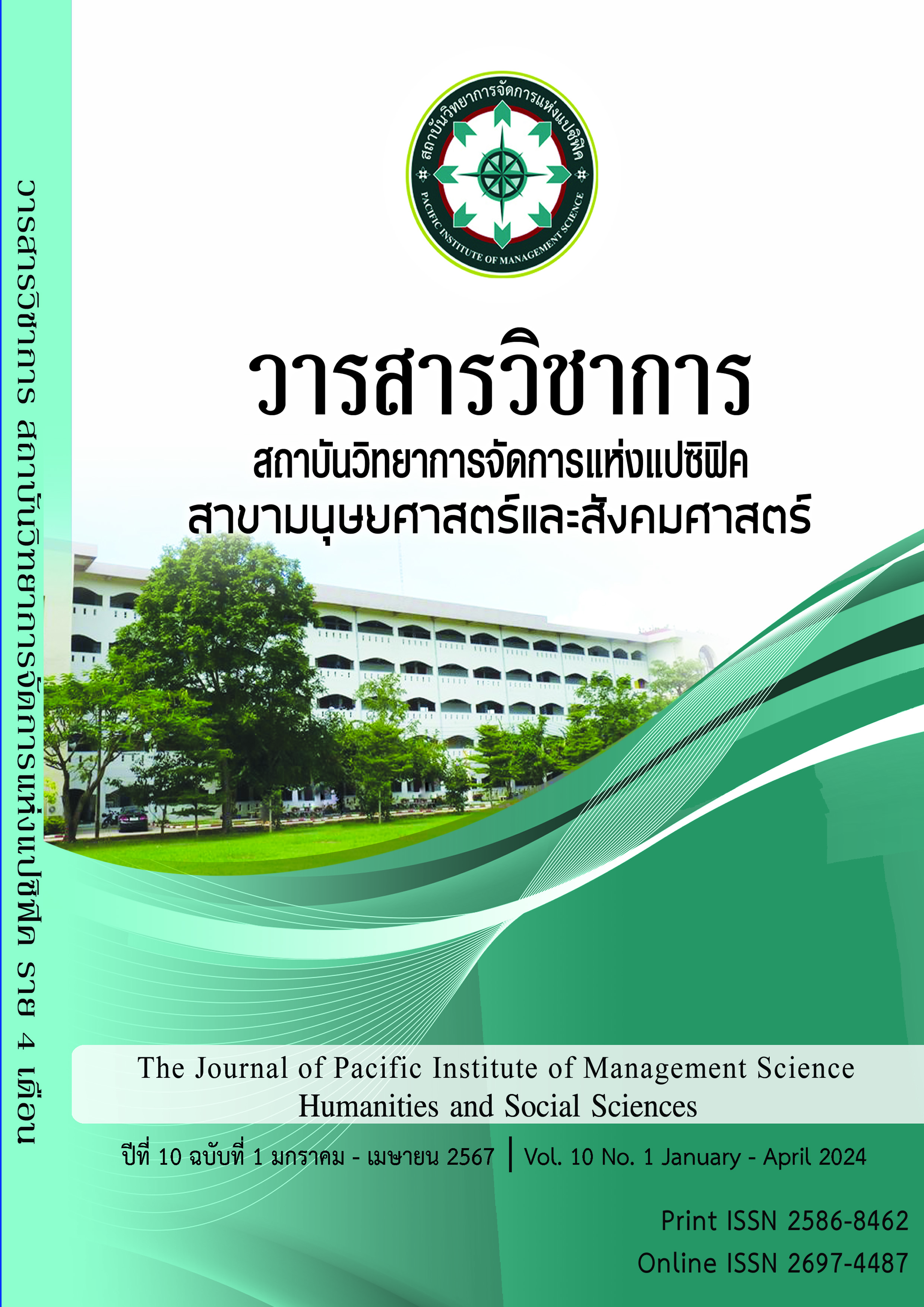A Study of Role Components of Physical Education Teachers in the 21st Century: A Case Study of Schools in Secondary Educational Service Area 13, Trang-Krabi, Academic Year 2023
Keywords:
Components, Roles of Physical Education Teachers, , In the 21st Century, Secondary Educational Service Area 13, Trang-KrabiAbstract
The purpose of this research is to study the elements of the physical education teacher's role in the 21st century, a case study of Secondary School Area 13, Trang - Krabi, academic year 2023, using research and development methods. The tool is a questionnaire for analysis using statistics, averages, standard deviations, using a sample of 360 people, confirmatory elements. (Confirmatory Factor Analysis: CFA)
The results indicated as follows: 1)The suitability test for component analysis using the Pearson's Product - moment Correlation Coefficient test found that there was a statistically significant positive correlation at the .01 level. 2)The test of the suitability of the data with the KMO index (Kaiser-Meyer - Olkin Measure of Sampling Adequacy) found that the index value of the Kaiser - Mayer - Olkin Measures of Sampling Adequacy (MSA) was 0.92, which was greater than 0.6. and the statistical value of Bartlett's test of Sphericity was 22830.56 with statistical significance (p=.00). This indicated that all variables were correlated with each other while being very favorably suitable for component analysis. 3)The results of the component analysis of physical education teachers in the 21st century under a case study of schools in the Secondary Educational Service Area 13, Trang-Krabi, academic year 2023 consisted of 5 components, 84.553%, sorted by descending Eigenvalues as follows: 1) The role of physical education teachers in knowledge and teaching skills (9.484) 2) The role of physical education teachers in management services (7.021) 3) The role of physical education teachers in learning management (6.044) 4) The role of physical education teachers in teacher ethics (4.151) 5) The role of physical education teachers in innovation and technology (3.740).
References
ฉัตรพันธ์ ดุสิตกุล. (2555). ผลของการจัดกิจกรรมพลศึกษาโดยใช้เกมกลุ่มสัมพันธ์ที่มีต่อพฤติกรรมก้าวร้าว
ของนักเรียนประถมศึกษา. ครุศาสารทมหาบัณฑิต (สุขศึกษาและพลศึกษา). คณะครุศาสตร์
จุฬาลงกรณ์มหาวิทยาลัย.
ชัยยนต์ เพาพาน. (2559). แนวคิดและทฤษฎีพื้นฐานการเป็นผู้นำของผู้บริหารสถานศึกษาในศตวรรษที่
วารสารบริหารการศึกษา มหาวิทยาลัยขอนแก่น. 12(1). 1-9.
ชาลี ไตรจันทร์. (2551). การกำหนดและประเมินสมรรถนะบุคลากรภาครัฐที่เหมาะสมในพื้นที่ 3
จังหวัดชายแดนภาคใต้. สืบค้นจาก http://kb.psu.ac.th/psukb/bitstream/2553/
/2/294256.pdf
ดาราวรรณ สุขคันธรักษ์. (2557). ยุทธศาสตร์การขับเคลื่อนการบริหารงานวิซาการของสถานศึกษาขั้นพื้นฐานสู่ประชาคมอาเชียน. วิทยานิพนธ์ปริญญาปรัชญาดุษฎีบัณฑิต สาขาวิชา การบริหารการศึกษา คณะศึกษาศาสตร์ มหาวิทยาลัยศิลปากร.
ธงชัย สันติวงษ์. (2541). ทฤษฎีองค์การและการออกแบบองค์การ. กรุงเทพมหานคร: ไทยวัฒนาพานิช.
นนชัย ศานติบุตร. (2550). การนำเสนอรูปแบบการพัฒนาฟุตบอลอาชีพของประเทศไทย. จุฬาลงกรณ์
มหาวิทยาลัย. กรุงเทพฯ. DOI=10.14457/CU.the.2007.890
นิสดารก์ เวชยานนท์. (2553). Competency-Based Approach. (พิมพ์ครั้งที่ 4). นนทบุรี:
เดอะกราฟิโก ซิสเต็มส์.
พงษ์เอก สุขใส. (2561). ครูพลศึกษาในศตวรรษที่ 21. วารสารวิชาการมหาวิทยาลัยฟาร์อีสเทอร์น.
(3). 8-21.
มลิวัลย์ ผิวคราม. (2551). การวิเคราะห์องค์ประกอบสมรรถภาพทางวิชาชีพ สำหรับนักศึกษา.
สาขาวิชาพลศึกษาและวิทยาศาสตร์การกีฬา สถาบันการพลศึกษา: โมเดลจาก 3 มุมมอง.
สถาบันการพลศึกษา วิทยาเขตชุมพร.
วณิช นิรันตรานนท์ และศศิธร นิรันตรานนท์. (2553). ทิศทางการผลิตครูพลศึกษาในช่วง 15 ปี (พ.ศ.
-2565). วารสารวิชาการ สถาบันการพลศึกษา. 2(2). 79-89.
วิจารณ์ พานิช. (2555). วิถีสร้างการเรียนรู้เพื่อศิษย์ในศตวรรษที่ 21. กรุงเทพฯ: มูลนิธิสดศรีสฤษดิ์วงศ์.
วิจารณ์ พานิช. (2556). วิถีสร้างการเรียนรู้เพื่อศิษย์. (พิมพ์ครั้งที่ 3). กรุงเทพมหานคร: ฝ่ายโรงพิมพ์ บริษัท
ตถาตา พับลิเคชั่น.
เสาวลักษณ์ ประมาน ต่อศักดิ์ แก้วจรัสวิไล และธีรนันท์ ตันพานิชย์. (2565). สมรรถนะครูพลศึกษา.
วารสารศิลปศาสตร์และวิทยาการจัดการ. 9(1). 153-164.
สมชนก ลดาดก. (2559).การพัฒนาโมเดลการวัดบทบาทครูเพื่อการเรียนรู้ของผู้เรียนในศตวรรษที่ 21:การทดสอบความไม่แปรเปลี่ยนของการวัด. สืบค้นจากhttp://cuir.car.chula.ac.th/handle/1234 56789/58438.
สุทธิวัฒน์ มากมี. (2561). อนาคตภาพการบริหารโรงเรียนประถมศึกษาในประเทศไทย. วารสารการ
บริหารการศึกษา มหาวิทยาลัยศิลปากร. 9 (1). 245-247.
อาทิตย์ โพธิ์ศรีทอง. (2562). อนาคตภาพของคุณลักษณะครูดนตรีในทศวรรษหน้า (พ.ศ.2561-2571).
วารสารวิจัยทางการศึกษา คณะศึกษาศาสตร์ มหาวิทยาลัยศรีนครินทรวิโรฒ ประสานมิตร. 14(1). 62-70
Hair, J.F., Black, W.C., Babin, B.J. & Anderson, R.E. (2010). Multivariate Data Analysis. (7th
ed.). Pearson: New York.
Konukman Ferman, Bülent Agbuğa, Şamil Erdoğan, Erdal Zorba , Giyasettin Demirhan , İlker
Yılmaz. (2010). Teacher-Coach Role Conflict in School-Based Physical Education in
USA: A Literature Review and Suggestions for the Future. Information Analyses; Journal Articles; Reports – Evaluative.2.(19).21-24.
Petrova, E., Jansone, D. & Silkane V. (2014). The development and assessment of
competencies in Vidzeme University of Applied Sciences. Procedia – Social and
Behavioral Sciences, 140, 241-245.
Rothwell, W.J., & Graber, J.M. (2010). Competency-based training basics. The United State
of America: Versa Press Inc.
Schumacker, R. E.,& Lomax, R. G. (2010). A beginner’s guide to structural equation
modeling. (3rd Edition). New Jersey: Lawrence Erlbaum Associates
Smith, R. and Lynch, D. (2010). Rethinking Teacher Education: Teacher Education in a
Knowledge Age, AACLM Press: Sydney
Downloads
Published
Issue
Section
License
Copyright (c) 2024 Pacific Institute of Management Science

This work is licensed under a Creative Commons Attribution-NonCommercial-NoDerivatives 4.0 International License.
บทความที่ได้รับการตีพิมพ์เป็นลิขสิทธิ์ของ สถาบันวิทยาการจัดการแห่งแปซิฟิค
ข้อความที่ปรากฏในบทความแต่ละเรื่องในวารสารวิชาการเล่มนี้เป็นความคิดเห็นส่วนตัวของผู้เขียนแต่ละท่านไม่เกี่ยวข้องกับสถาบันวิทยาการจัดการแห่งแปซิฟิค และคณาจารย์ท่านอื่นๆในสถาบันฯ แต่อย่างใด ความรับผิดชอบองค์ประกอบทั้งหมดของบทความแต่ละเรื่องเป็นของผู้เขียนแต่ละท่าน หากมีความผิดพลาดใดๆ ผู้เขียนแต่ละท่านจะรับผิดชอบบทความของตนเองแต่ผู้เดียว







